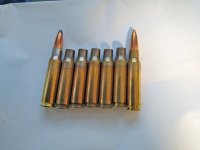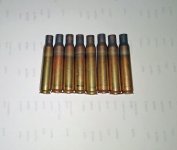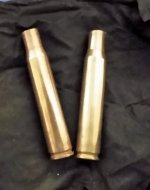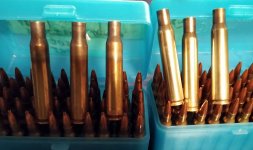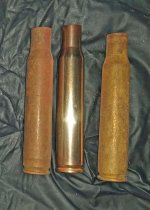Reading a third language skill ???
NO cartridge manufacturer including Lapua actually anneals ANY cartridge case !. They simply use a multiple station annealing induction machine ,to induce ductility
NOT anneal . Consider Temperature and Dwell TIME . Brass sheet is puck punched , then drawn into case form through a series of draws ( Yes Brass at this stage might be held at temp for ductility purpose but again NOT annealed . Think about it CASE HEAD is nearly fully work hardened by drawing and press forming . The head is where the STRENGTH is needed most and Body somewhat ,Neck and shoulder NO ,not so much it's why the witness rainbow of ductility induction is present . Most Military rounds are Not polished ,only commercial and home reloaders polish . Annealing steel HARDENS it ,annealing BRASS softens it ,as BOTH orientate GRAIN STRUCTURE aka recrystallization .
Decades ago I had George cut #6 New cases of mine and do an analysis on them . NOT a single one showed any annealing in the true sense of the word , using OES and TEM machines . Cartridge brass Alloy of copper and zinc. Commonly contains lead. Also may include iron, manganese, aluminum, silicon and other elements as well . SI aka Silicon imparts Hardness in brass . Benefits better corrosion resistance ,lower conductivity improves strength ,considered High Strength Brass . I don't remember all the details as it was in the 90's but DO remember Laupa had a higher % content of SI ,then other cases he tortured or I sacrificed

Annealing experiments were conducted on a number of the cold worked specimens. Figures 5a and b show color etched images of the specimens cold reduced 50% and then annealed 30 minutes at 500 and 700°F.
No difference in the microstructure is seen in the specimen held 30 minutes at 500°F while a very small amount of recrystallization is observed in the specimen held 30 minutes at 700°F. Figures 6a and b show color images of 50% cold reduced specimens held for 4 and 8 minutes at 800°F while Figures 6c and d show 50% cold reduced specimens held 15 and 30 minutes at 800°F. No change is observed after 4 minutes at 800°F, while a minor amount of recrystallization has occurred after 8 minutes.
Holding specimens for 15 and 30 minutes at 800°F revealed partial recrystallization after 15 minutes and full recrystallization after 30 minutes. The grain structure is relatively fine but is not uniform in its distribution.
Figures 7a and b illustrate the grain structure in color after 15 and 30 minutes at 900°F. The 15 minute hold produced a non-uniform grain structure while the 60 minute hold produced better results although the grain size distribution appears to be duplex. Figures 8a and b show a B&W and a color image (Klemm’s I reagent)
after annealing 30 minutes at 1300°F which produced a fully recrystallized, uniform grain size distribution but coarse grained (as in Figs. 1 and 3a). Figures 8c and d show the same specimen but color tint etched using Klemm’s III and Beraha’s PbS tint etchants. Both are excellent for use with cartridge brass. Tint etchants also reveal details about the presence, or absence, of crystallographic texture. We note that as the cartridge brass is cold reduced greater amounts the grain coloring becomes more monotone, while when the annealing temperature is increased resulting in fully recrystallized grains with increasing size, the coloring becomes more variable with a random distribution of the colors. A random dispersion of a broad range of colors indicates that we have a random crystallographic texture while a narrow color range suggests that we have a preferred texture.
Annealing experiments were conducted on a number of the cold worked specimens. Figures 5a and b show color etched images of the specimens cold reduced 50% and then annealed 30 minutes at 500 and 700°F.
No difference in the microstructure is seen in the specimen held 30 minutes at 500°F while a very small amount of recrystallization is observed in the specimen held 30 minutes at 700°F. Figures 6a and b show color images of 50% cold reduced specimens held for 4 and 8 minutes at 800°F while Figures 6c and d show 50% cold reduced specimens held 15 and 30 minutes at 800°F.
No change is observed after 4 minutes at 800°F, while a minor amount of recrystallization has occurred after 8 minutes. Holding specimens for 15 and 30 minutes at 800°F revealed partial recrystallization after 15 minutes and full recrystallization after 30 minutes. The grain structure is relatively fine but is not uniform in its distribution.
The entire point of MY posting this was so that YOU ,could determine IF YOU were really doing YOUR brass any real service by pretending too anneal it !?. I impart ductility personally and use Higher heat at a mid Dwell , and FYi The ONLY way I know to RUIN a cartridge case in heating ,is allowing the Mid body or base to ever reach 400 F. Deg.
THAT IS RUINING A CASE !. My necks and shoulders see 1100-1300 F. Deg ,yet the bases NEVER exceed 250 F. Deg. and I Don't stand them in water or tip them ,unnecessary IMO does Nothing .
IF one stops and thinks about this ,you will understand a cartridge case CAN'T BE ANNEALED and used for it's intended purpose .
Think of your case as a head gasket ,yep metallic . Neck expands then Seals chamber so gases move forward ,shoulder shifts to retard expansion of body . IF it's hard it's gonna SPLIT or allow carbon blow by . 
